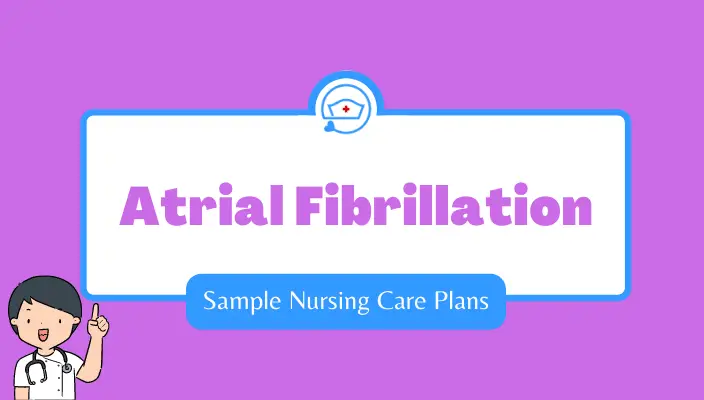Here we will formulate sample Hypokalemia nursing care plans based on a hypothetical case scenario.
It will include three Hypokalemia nursing care plans with NANDA nursing diagnoses, nursing assessment, expected outcome, and nursing interventions with rationales.
Hypokalemia Case Scenario
A 57-year old male presents to the ED with complaints of nausea, weakness, heart palpitations, and mild shortness of breath. The patient has a past medical history of heart failure and takes furosemide (Lasix) daily.
The patient says: “I’ve been on Lasix for years now so I know what to expect, but I still think I’ve been urinating more than usual.” He also reports thirst and constipation, but he was careful not to drink excess water because of his heart failure.
For the past few nights, he has had severe leg cramps that have woken him up. The patient thought his potassium might be low, so he ate 2 apples with no improvement noted.
When he started to feel heart palpitations and shortness of breath, he decided to come to the hospital.
Upon assessment, the patient is alert and oriented and follows commands appropriately.
His temperature is 37.4 ˚C, heart rate is 122 beats per minute, blood pressure is 142/84 mmHg, respirations are 20 breaths per minute, and oxygen saturation is 98% on room air.
The patient’s lung sounds are clear. No edema is noted, and in fact, mild tenting is noted on the back of the patient’s hand.
A 12-lead ECG is performed and shows sinus tachycardia with PVCs. Cardiac enzymes are normal but his potassium level is 2.8 mmol/L.
The patient is admitted to the hospital for Hypokalemia.
#1 Sample Hypokalemia Nursing Care Plan – Risk for decreased cardiac tissue perfusion
Nursing Assessment
Subjective Data:
- The patient complains of weakness, nausea, heart palpitations, and shortness of breath.
Objective Data:
- The patient is tachycardic and PVCs are noted on ECG.
- The patient is hypertensive.
- His potassium level is 2.8 mmol/L.
Nursing Diagnosis
Risk for decreased cardiac tissue perfusion related to severe potassium deficiency as evidenced by heart palpitations, tachycardia, and presence of PVCs.
Goal/Desired Outcome
Short-term goal: By the end of the shift the patient will experience a resolution of heart palpitations and shortness of breath, with no further PVCs seen on ECG.
Long-term goal: The patient will maintain a normal potassium level, monitoring for recurrent signs and symptoms of hypokalemia.
Nursing interventions with rationales for hypokalemia – Risk for decreased cardiac tissue perfusion
| Nursing Interventions | Rationales |
| Continuously monitor ECG. | With a critically low potassium level, the patient is at risk for ventricular arrhythmias. |
| Monitor potassium every 6 hours or as needed. | Potassium levels should be closely monitored during repletion, making sure the level is rising but does not exceed 4.0 mmol/L. |
| Maintain strict intake and output. | Hypokalemia is a side effect of diuretic administration and the patient is showing signs of dehydration. Closely monitoring intake and output can help assess the patient’s current fluid status and will guide treatment. |
| Consider temporarily holding diuretics. | Diuretics may be temporarily paused until potassium level increases and fluid status is normalized. |
| Perform a daily weight. | Weight should be performed every day to help assess fluid volume status. It should ideally be done at the same time and same method (standing, bed weight, etc.) each day. A standing weight is the most accurate. |
| Monitor for breathing difficulties. | Breathing requires many muscles, particularly the diaphragm, which require potassium in order to work properly. A potassium deficiency can result in shortness of breath, and in severe cases, can stop the lungs from working completely. |
#2 Sample Hypokalemia Nursing Care Plan – Activity intolerance
Nursing Assessment
Subjective Data:
- The patient is experiencing weakness, heart palpitations, and shortness of breath.
Objective Data:
- The patient is tachycardic and PVCs are noted on ECG.
- His potassium level is 2.8 mmol/L.
Nursing Diagnosis
Activity intolerance related to insufficient potassium to support regular body functions as evidenced by weakness, palpitations, and shortness of breath.
Goal/Desired Outcome
Short-term goal: By the end of the shift the patient’s potassium will normalize and the patient will experience a resolution of symptoms.
Long-term goal: At home, the patient will take a daily potassium supplement in addition to his regular diuretic.
Nursing interventions with rationales for hypokalemia – Activity intolerance
| Nursing Interventions | Rationales |
| Supplement with oral potassium. | If able to eat and drink, administer PO potassium. Potassium pills are quite large – if the patient has a difficult time swallowing, consider potassium powder or IV administration. |
| Do not crush oral potassium pills. | Pills should not be crushed but can be dissolved in 3.8 ounces of cold water or juice. |
| Administer oral potassium with food. | PO potassium can cause stomach upset so it’s best to administer with food or after meals. |
| Administer IV potassium. | Rapid administration of IV potassium can cause cardiac arrest so an IV pump should always be used. Carefully check the administration rate, with 2 nurses if needed. |
| Adjust the IV potassium dose and rate depending on the available IV access. | IV potassium can cause serious extravasation and vein irritation. Peripherally – potassium should be administered no faster than 10 mEq per hour. Common concentrations are 10 mEq/100 ml over 1 hour or 40 mEq/250 ml over 4 hours. Centrally – potassium can be administered more quickly and in larger doses via this route. Common concentrations are 20 mEq/100 ml over 1 hour or 40 mEq/100 ml over 2 hours. |
| Prepare for central line administration. | Because potassium can only be administered slowly and in small doses via a peripheral IV, a central line is recommended to correct hypokalemia more quickly. |
| Consider IV maintenance fluids with potassium added. | IV fluids with added potassium would be appropriate for dehydrated and hypokalemic patients, or if the patient required ongoing diuretic administration despite low potassium. |
#3 Sample Hypokalemia Nursing Care Plan – Knowledge deficit
Nursing Assessment
Subjective Data:
- The patient thought apples were high in potassium.
Objective Data:
- His potassium level is 2.8 mmol/L.
Nursing Diagnosis
Deficient knowledge related to diuretic side-effects and hypokalemia as evidenced by the patient thinking apples were high in potassium.
Goal/Desired Outcome
Short-term goal: By the end of the shift the patient will be able to list a few foods high in potassium.
Long-term goal: The patient will eat a broad variety of fruits and vegetables, with knowledge of a few high-potassium foods to eat in case of suspected hypokalemia.
Nursing interventions with rationales for hypokalemia – Knowledge deficit
| Nursing Interventions | Rationales |
| Educate the patient about high-potassium foods. | Bananas, oranges, apricots, cooked spinach, potatoes, and mushrooms are all high in potassium. |
| Educate the patient about the role of potassium in the body. | Potassium is an essential mineral that is responsible for fluid balance, regulating nerve signals, and muscle contraction. It can result in serious injury or death if it becomes too high or too low. |
| Educate the patient about the symptoms of hypokalemia. | The patient should be able to monitor for hypokalemia, which is common with diuretic administration. Symptoms include fatigue, weakness, nausea, heart palpitations, shortness of breath, leg cramps, polyuria, polydipsia, and constipation. |
| Consider switching to a potassium-sparing diuretic. | If hypokalemia becomes a recurrent issue, the patient may be switched to a diuretic that conserves potassium. Furosemide is a potassium wasting diuretic but diuretics such as Spironolactone (Aldactone) or Amiloride (Midamor) are potassium-sparing diuretics. |
Conclusion
To conclude, here we have formulated a scenario-based nursing care plan for Hypokalemia. Prioritized nursing diagnosis includes risk for decreased cardiac tissue perfusion, activity intolerance, and deficient knowledge.
Additionally, this sampleHypokalemianursing care plan comprises nursing assessment, NANDA nursing diagnosis, goal, and interventions with rationales.
Recommended Readings & References
Ackley, B., Ladwig, G., Makic, M., Martinez-Kratz, M., & Zanotti, M. (2020). Nursing Diagnoses Handbook: An Evidence-based Guide to Planning Care (12th ed.). Elsevier.
Comer, S. and Sagel, B. (1998). CRITICAL CARE NURSING CARE PLANS. Skidmore-Roth Publications.
Herdman, T., Kamitsuru, S. & Lopes, C. (2021). NURSING DIAGNOSES: Definitions and Classifications 2021-2023 (12th ed.). Thieme.
Swearingen, P. (2016). ALL-IN-ONE CARE PLANNING RESOURCE (4th ed.). Elsevier/Mosby.




